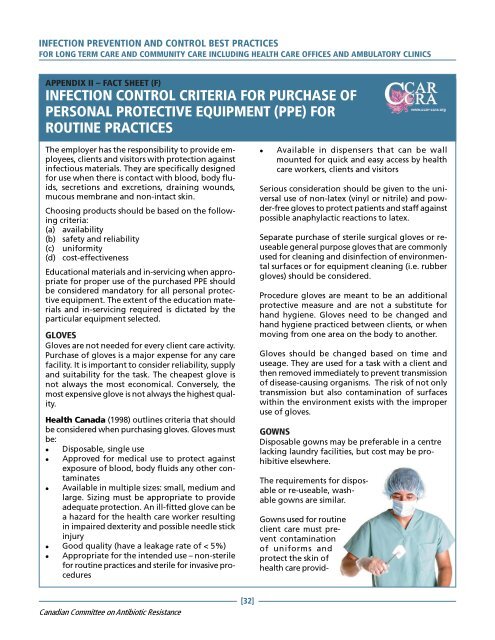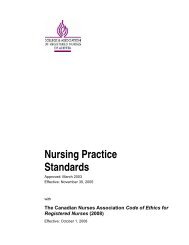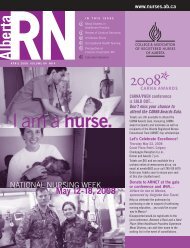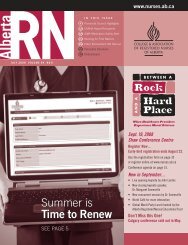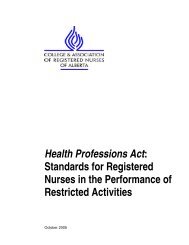Infection Prevention and Control Best Practices - College ...
Infection Prevention and Control Best Practices - College ...
Infection Prevention and Control Best Practices - College ...
You also want an ePaper? Increase the reach of your titles
YUMPU automatically turns print PDFs into web optimized ePapers that Google loves.
INFECTION PREVENTION AND CONTROL BEST PRACTICES<br />
FOR LONG TERM CARE AND COMMUNITY CARE INCLUDING HEALTH CARE OFFICES AND AMBULATORY CLINICS<br />
APPENDIX II – FACT SHEET (F)<br />
INFECTION CONTROL CRITERIA FOR PURCHASE OF<br />
PERSONAL PROTECTIVE EQUIPMENT (PPE) FOR<br />
ROUTINE PRACTICES<br />
The employer has the responsibility to provide employees,<br />
clients <strong>and</strong> visitors with protection against<br />
infectious materials. They are specifically designed<br />
for use when there is contact with blood, body fluids,<br />
secretions <strong>and</strong> excretions, draining wounds,<br />
mucous membrane <strong>and</strong> non-intact skin.<br />
Choosing products should be based on the following<br />
criteria:<br />
(a) availability<br />
(b) safety <strong>and</strong> reliability<br />
(c) uniformity<br />
(d) cost-effectiveness<br />
Educational materials <strong>and</strong> in-servicing when appropriate<br />
for proper use of the purchased PPE should<br />
be considered m<strong>and</strong>atory for all personal protective<br />
equipment. The extent of the education materials<br />
<strong>and</strong> in-servicing required is dictated by the<br />
particular equipment selected.<br />
GLOVES<br />
Gloves are not needed for every client care activity.<br />
Purchase of gloves is a major expense for any care<br />
facility. It is important to consider reliability, supply<br />
<strong>and</strong> suitability for the task. The cheapest glove is<br />
not always the most economical. Conversely, the<br />
most expensive glove is not always the highest quality.<br />
Health Canada (1998) outlines criteria that should<br />
be considered when purchasing gloves. Gloves must<br />
be:<br />
� Disposable, single use<br />
� Approved for medical use to protect against<br />
exposure of blood, body fluids any other contaminates<br />
� Available in multiple sizes: small, medium <strong>and</strong><br />
large. Sizing must be appropriate to provide<br />
adequate protection. An ill-fitted glove can be<br />
a hazard for the health care worker resulting<br />
in impaired dexterity <strong>and</strong> possible needle stick<br />
injury<br />
� Good quality (have a leakage rate of < 5%)<br />
� Appropriate for the intended use – non-sterile<br />
for routine practices <strong>and</strong> sterile for invasive procedures<br />
Canadian Committee on Antibiotic Resistance<br />
[32]<br />
� Available in dispensers that can be wall<br />
mounted for quick <strong>and</strong> easy access by health<br />
care workers, clients <strong>and</strong> visitors<br />
Serious consideration should be given to the universal<br />
use of non-latex (vinyl or nitrile) <strong>and</strong> powder-free<br />
gloves to protect patients <strong>and</strong> staff against<br />
possible anaphylactic reactions to latex.<br />
Separate purchase of sterile surgical gloves or reuseable<br />
general purpose gloves that are commonly<br />
used for cleaning <strong>and</strong> disinfection of environmental<br />
surfaces or for equipment cleaning (i.e. rubber<br />
gloves) should be considered.<br />
Procedure gloves are meant to be an additional<br />
protective measure <strong>and</strong> are not a substitute for<br />
h<strong>and</strong> hygiene. Gloves need to be changed <strong>and</strong><br />
h<strong>and</strong> hygiene practiced between clients, or when<br />
moving from one area on the body to another.<br />
Gloves should be changed based on time <strong>and</strong><br />
useage. They are used for a task with a client <strong>and</strong><br />
then removed immediately to prevent transmission<br />
of disease-causing organisms. The risk of not only<br />
transmission but also contamination of surfaces<br />
within the environment exists with the improper<br />
use of gloves.<br />
GOWNS<br />
Disposable gowns may be preferable in a centre<br />
lacking laundry facilities, but cost may be prohibitive<br />
elsewhere.<br />
The requirements for disposable<br />
or re-useable, washable<br />
gowns are similar.<br />
Gowns used for routine<br />
client care must prevent<br />
contamination<br />
of uniforms <strong>and</strong><br />
protect the skin of<br />
health care provid-


